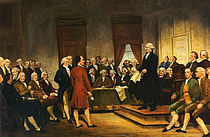Mixed Federalism – The United States of America
 The international format of the federal idea prevailed at the time of the American Revolution. And it is only against the intellectual background of eighteenth-century federal thought that we can appreciate the semantic revolution that was to take place in America. The ‘Articles of Confederation and Perpetual Union’—the first American Constitution—had still breathed the classic tradition of the federal principle. The semantic departure from the classic tradition came only with the second American Union. The meaning of the federal principle would be forever changed by the most important ‘speech act’ in the history of constitutional federalism: the 1787 Constitution of the United States of America.
The international format of the federal idea prevailed at the time of the American Revolution. And it is only against the intellectual background of eighteenth-century federal thought that we can appreciate the semantic revolution that was to take place in America. The ‘Articles of Confederation and Perpetual Union’—the first American Constitution—had still breathed the classic tradition of the federal principle. The semantic departure from the classic tradition came only with the second American Union. The meaning of the federal principle would be forever changed by the most important ‘speech act’ in the history of constitutional federalism: the 1787 Constitution of the United States of America.
This subproject builds on some of Schuetze’s previous work on (early) American federalism. It looks at the Madisonian understanding of the federal idea, and in particular at the constitutional debates over the nature of federalism in nineteen-century America. What is striking about the nineteenth century American discourse is – except for the period surrounding the Civil War (1861-65) – the absence of the abstract idea of sovereignty
(researched by Prof. Robert Schütze)